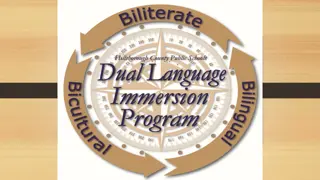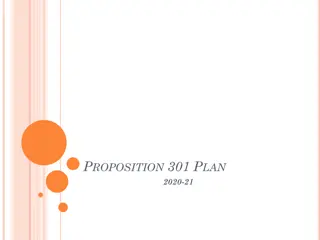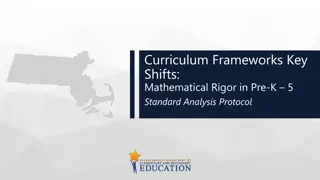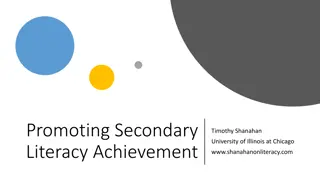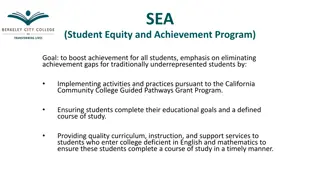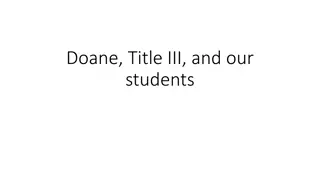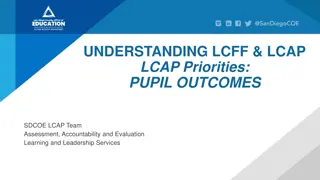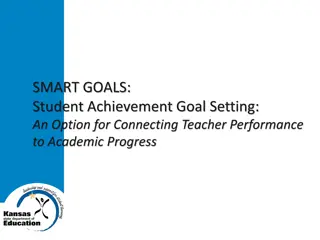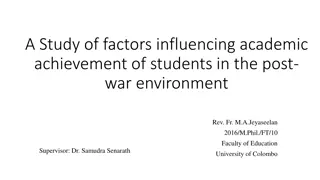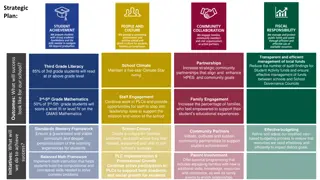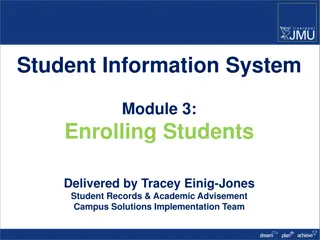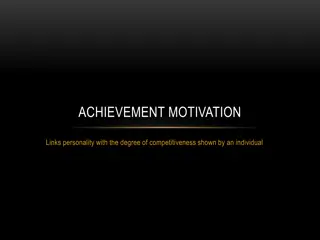Strategies for Enhancing Academic Rigor and Student Achievement
Enhance academic rigor and student achievement by aligning course content with college-level expectations, providing opportunities for knowledge construction, teaching problem-solving and critical thinking, and embracing productive struggle as part of the learning process. These strategies aim to elevate coursework in lower-level classes to match the rigor of higher-level classes, fostering a college-like learning environment that challenges students while supporting their growth and success.
Download Presentation

Please find below an Image/Link to download the presentation.
The content on the website is provided AS IS for your information and personal use only. It may not be sold, licensed, or shared on other websites without obtaining consent from the author.If you encounter any issues during the download, it is possible that the publisher has removed the file from their server.
You are allowed to download the files provided on this website for personal or commercial use, subject to the condition that they are used lawfully. All files are the property of their respective owners.
The content on the website is provided AS IS for your information and personal use only. It may not be sold, licensed, or shared on other websites without obtaining consent from the author.
E N D
Presentation Transcript
Rigorous Support Helping Students Achieve the Expectations We Set for Them
The Concept of Rigor: A Brief Introduction Course work "feels like college, not middle school" Challenging, yet possible
The Concept of Rigor: A Brief Introduction (According to the CCRC) In their 2013 article "Enhancing Rigor in Developmental Education," the CCRC recommends three strategies for "scaling" course work in lower-level classes to match expectations in higher-level.
Align content with college-level course expectations. Align The Concept of Rigor: A Brief Introduction (According to the CCRC) Provide consistent opportunities for students to construct knowledge. Provide Make Make struggle part of the process.
The Concept of Rigor: A Brief Introduction (Align Coursework with Higher-Level Class) Don't just re-teach k-12 content in lower-level class. Teach the skills needed to do the work of the college-level class. The lower-level class is not a study hall!
The Concept of Rigor: A Brief Introduction (Allow students to construct knowledge). Don't just teach "fact transmission and recall." Aim to teach "problem solving and critical thinking." Encourage students to "build conceptual connections between texts, ideas, and experiences."
The Concept of Rigor: A Brief Introduction (Make Struggle Part of the Process) Many teachers are afraid to make struggle part of the process but they shouldn't be! The worry is that students aren't ready, especially developmental students, and that struggle can hurt them more than help them Not true! In fact, the opposite is true: students who don't struggle won't engage. This should be "productive struggle" "Productive struggle occurs when students are solving problems that are within reach and grappling with key disciplinary ideas that are comprehendible."
The Concept of Rigor: A Brief Introduction (ALP at Butler CC) In our program here at BCC, both the EG 060 course and the EG 101 course contain "rigorous content." We "scaffold" the 060 course to teach concepts students will need later in the 101 course. Remember: the lower-level course is not a study hall! It should have separate course work to teach the skills students are going to need later in the "college-level" course.
The Concept of Rigor: A Brief Introduction (According to the CCRC) "Not only are low-skilled and seemingly low-motivated students able to engage in complex learning tasks, but they also report being more involved and becoming more self- directed and confident learners when classroom standards are higher. Moreover, preliminary internal analyses at several colleges indicate that students who complete rigorous courses persist and perform well in subsequent courses."
We don't just add rigor . . . . We also add support!
Rigorous Reading Assignments Rigorous Writing Assignments Rigorous Grading Let's consider three places to add rigor and support to our courses
And then, I'll open the floor to your ideas, so be thinking about how you build in both "rigor" and "support."
Rigorous Reading Assignments Are challenging in the complexity of ideas presented and language used Are a) artistic and creative texts that engage with deep societal concerns Are b) non-fiction texts that explore cultural and historical issues Are "sufficient in number" (a semester with only a handful of readings over 16 weeks is not considered "college-level work") Both the "lower level" and the "college level" course contains reading assignments, since the lower level is not a study hall.
Some Challenges We Face When Assigning Rigorous Readings Many of our students struggle with reading Many resist reading assignments, attempting to avoid them Many were allowed to move on in earlier schooling without participating in reading assignments. Many are enrolled simultaneously in remedial reading courses
The Best Tool for Support: The Reading Cycle PRE-READING READING POST READING
Give students an overview of the content before they read. The Reading Cycle Part 1 Teach them what they will need to know to understand the reading (background info, vocabulary, etc.)--go ahead and lecture if you have to! PRE- READING You can even have them map out when they will read it in their planners, how much time it will take, etc.
The goal is to have students do "active," not "passive" reading. The Reading Cycle Part 2 Don't just expect them to read because the assignment is on the syllabus give them something to do that carries some points. Good strategies include annotations, reading logs, summary / response. READING Use this homework as a ticket to participate during in- class activities (students who don't have the reading homework might miss out on participation points since they'll do the homework in class).
Do not expect students to come to class and have graduate-level discussions! The Reading Cycle Part 3 Try strategies like "Think, Pair, Share" that allow students to work on their ideas before the in-class discussion. Hand out graphic organizers before a discussion and allow students to work collaboratively. Be ready for (and accepting of) more retelling and summarizing than deep analysis at least at first. POST- READING Have students write about their reading assignment before they discuss it in class.
Rigorous Writing Assignments Are specific, unique, and tied to course content Are NOT generic assignments focused on a mode of writing Are complex and challenging Often involve synthesis of sources / research
Supporting Students While They Do Rigorous Writing Assignments Focused peer review (focused = you give them specific tasks to do during the peer review, and don't just tell them to do one without further guidance about what they should be looking for) Focused self review Required use of tutoring services Required conferences with you (out of class, sparingly OR in class frequently)
Remember: the lower-level class is not a study hall . . .
That doesn't mean that it can't be a writing workshop!
Or a place where you spend time working one-on-one with students as they do the challenging work for BOTH the "college-level" and the "dev ed" class.
As long as your "lower-level" class contains content of its own and is not just a study hall, you can (and should) occasionally take some time in it to do some personalized coaching and tutoring of your students
One last place to add some rigor and support: GRADING!
Require students to interact with your grading comments on their papers (choose one) 01 02 03 04 05 06 Have them correct errors or re-write a specific number of sentences to fix the problems you've identified Have them look up errors in their writing handbook or online Require them to work through exercises in the textbook to build needed skills Ask them to document improvements to a draft based on your grading comments on a previous paper. Have them do a full revision Have them conference with you to discuss your grading comments
Discussion: What do YOU do to add rigor and support?




